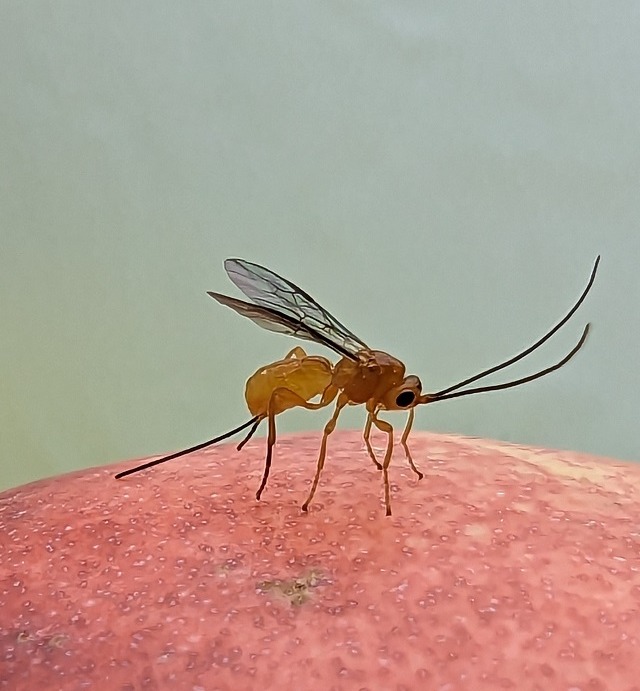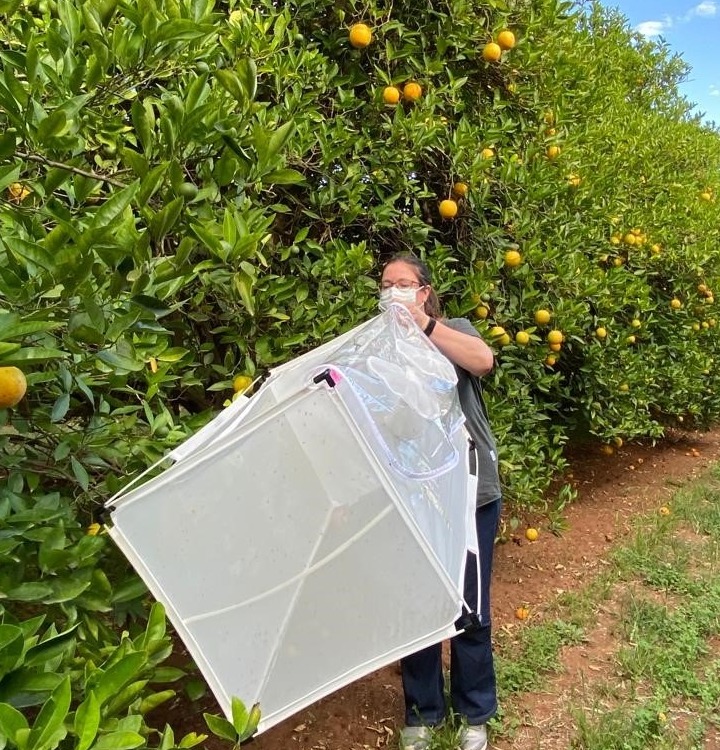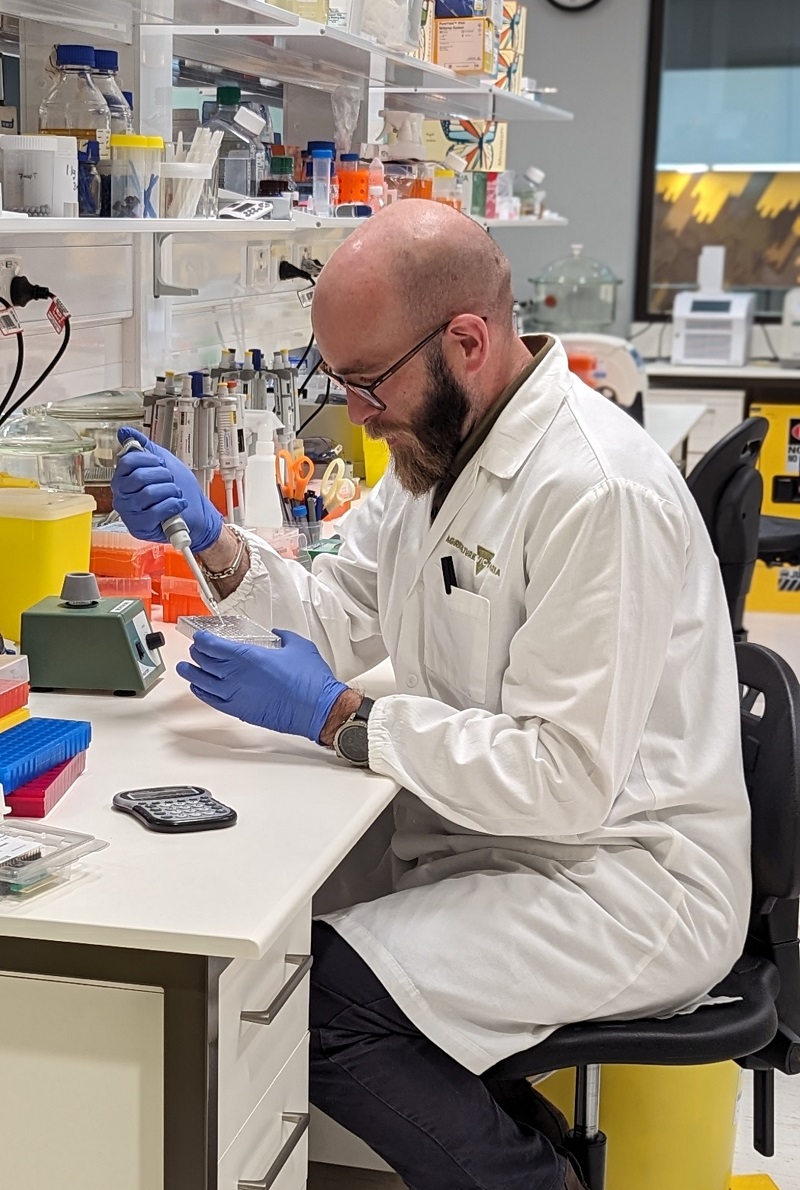Agriculture Victoria Queensland Fruit Fly management research
Fresh and Secure Trade Alliance (FASTA) overview
In July 2023, Hort Innovation commissioned the Fresh and Secure Trade Alliance (FASTA), which sees state governments and universities joining forces to deliver research that will help protect and grow Australia’s horticultural exports.
Fruit fly is a key focus of this 8-year research program, which incorporates biosecurity and pest management initiatives that will strengthen market access for horticulture.
Our research and biosecurity personnel are partners in this exciting program, leading components and activities in fruit fly surveillance (metabarcoding, fine scale 'track and trace' genomics), biocontrol (fruit fly parasitoids), and biopesticides (entomopathogenic fungi).
Parasitoids for biological control of QFF

Biocontrol – the use of natural enemies (often called 'beneficial insects') to manage pest populations – is a crucial component of integrated pest management (IPM) and area-wide management strategies to control insect pests.
However, for the Australian pest fruit flies, surprisingly little work has been carried out to explore the potential for biocontrol in fruit fly management.
Our research team has been exploring the use of parasitic wasps, or parasitoids, as biocontrol agents against QFF (Queensland Fruit Fly). The aim is to try and establish these key specialist predators in the state.
From 2020-2022, two fruit fly parasitoid species were collected from Queensland and Northern NSW and mass cultured at our Tatura SmartFarm.
 Ninety-five thousand parasitoids have been released across Victoria, predominantly in rural towns and cities where fruit flies can be problematic to manage.
Ninety-five thousand parasitoids have been released across Victoria, predominantly in rural towns and cities where fruit flies can be problematic to manage.
The research has shown very encouraging signs that one of the parasitoids (the native insect, Diachasmimorpha kraussii) is establishing well at local sites (Mildura and Swan Hill) and can survive the chilly Victorian winters and hot dry summers.
Further research on parasitoids is taking place as part of the new FASTA program, including additional inoculative releases in areas where fruit fly are present but parasitoids are rare or absent, and developing strategies for improving the use of these biocontrol agents in IPM.
Biopesticides against QFF
Microbial-based biopesticides are a new generation of environmentally friendly IPM tools that can be targeted and highly effective at controlling a wide range of insect pests. We have been investigating the use of insect killing (entomopathogenic) fungi (EPF) as prospective biopesticide agents for QFF, in particular at targeting the larval stages that bury into the soil to pupate.
Previous research carried out by us (DAWE 2020-2022) isolated naturally occurring EPF from the soil and screened these against different life stages of the fly. A number of highly effective species and strains of EPF were identified in the lab studies.
Research is continuing as part of the new FASTA program, testing these strains in conditions that are more similar to the field, including studies on formulation and application.
Since EPF are living agents and as such have known limitations, the research will focus on identifying and overcoming some of the specific challenges involved in achieving the in-field efficiency needed to control fruit flies in an IPM context.
For example, the research program will see the development and evaluation of possible delivery strategies for the EPF, with the aim to take advantage of the knowledge gained about the ecology, behaviour and susceptibility of fruit flies to pathogens.
Formulation will also be considered, to enhance the longevity of the EPF in the environment for maximum effect, by taking into account recent advances in formulation science and in the mass production of microbial agents.
Rapid insect diagnostics
Our researchers have been developing and evaluating new molecular technologies for improving fruit fly diagnostics.
A technique known as metabarcoding has been developed that enables simultaneous identification of multiple fruit fly species in a single batch.
 Metabarcoding identifies insects using DNA sequences and is suitable for processing large trap samples of fruit flies. This will help with fruit fly surveillance, particularly in northern Australia where a high diversity of species and many thousands of insects may be caught in traps each week.
Metabarcoding identifies insects using DNA sequences and is suitable for processing large trap samples of fruit flies. This will help with fruit fly surveillance, particularly in northern Australia where a high diversity of species and many thousands of insects may be caught in traps each week.
In 2024, as part of FASTA, we and our partners at Queensland DAF will evaluate metabarcoding for identification of fruit fly trap catches, as well as developing standard laboratory operating procedures for applying this technique for fruit fly monitoring and surveillance.
Our researchers have also developed metabarcoding technology as a surveillance tool for spotted-wing drosophila (SWD), a high priority exotic fruit fly pest that attacks ripening fruits, particularly berries.
Current SWD traps catch large numbers of non-pest drosophila fruit fly species, which must then be individually visually examined to ensure they are not SWD.
Research has focused on developing metabarcoding for rapid identification of insects in 'bulk' trap samples, paving the way for new scalable cost-effective surveillance programs for this and other highly destructive pests.
Over the past few years, we have applied metabarcoding for Drosophila species identification from exotic SWD surveillance trapping programs in Victoria, NSW and Queensland.
We have also extended the use of a technology called LAMP (loop mediated isothermal amplification), which can be used to quickly identify fruit fly eggs, larvae, and adults. LAMP can now identify major fruit fly pests including QFF and Medfly, high priority exotic pests such as SWD and the oriental fruit fly, as well as the lesser endemic pest (e.g. Jarvis’ fruit fly), and non-pest fruit fly species (such as island fly).
Other improvements to fruit fly molecular diagnostics (as part of FASTA) include developing new molecular tools for identification of morphologically similar species in fruit fly species complexes; including recent characterising of DNA variation to differentiate Queensland fruit fly from the closely related Bactrocera neohumeralis.
New genomic tools
Our researchers are developing fine-scale genomic tools for understanding genetic relationships between fruit fly pest populations, beginning with QFF (through FASTA).
These cutting-edge methods show potential for ‘tracking and tracing’ invasive flies at the critical early stages after an outbreak is detected, providing insights into their introduction pathway, population dynamics, movement patterns, and whether they represent a new incursion or local breeding population.
This novel information will improve the ability of biosecurity agencies and the horticulture industry to respond quickly and effectively to pest detections, thereby improving the chance of eradication and safeguarding fruit fly-free areas.
Additionally, our researchers are leveraging the increased availability of fruit fly genomes to understand the genetic mechanisms invasive fruit flies use to establish in new regions and fruit hosts, opening the door for new approaches to attract and exterminate these destructive pests.
Improved traps targeting female flies
Fruit fly traps contain attractant odours that lure adult flies into a trap and then kill them using an insecticidal bait.
Commercially available fruit fly traps either contain the synthetic odour 'cue-lure', which strongly attracts adult male QFF, or they contain a protein-based attractant (usually based on yeast) that attracts both sexes, but predominantly virgin (unmated) adult female flies.
New lures have now been developed (patents pending) that are based on fruit-odours and target mated female QFF, which directly damage fruits by 'stinging' fruits to lay their eggs.
Field trials have shown these new lures (and traps) can be more effective at trapping female flies compared to existing technologies.

Mass trapping fruit fly in table grapes
A recent project completed by us has been exploring the development of a mass trapping strategy for Queensland fruit fly in table grape vineyards.
The project trialled our newly developed 'mated female' fruit fly trap and looked at possible scenarios and strategies for mass trapping, including placing traps throughout the whole block, around the perimeter or in host trees and refuge sites.
Results showed that perimeter trapping might be the most cost-effective system for table grapes, but also revealed female QFF preferences for different grape varieties, and problems with using the current fruit-mimic trap design (a sticky trap) in and around Mildura where there are frequent dust storms.